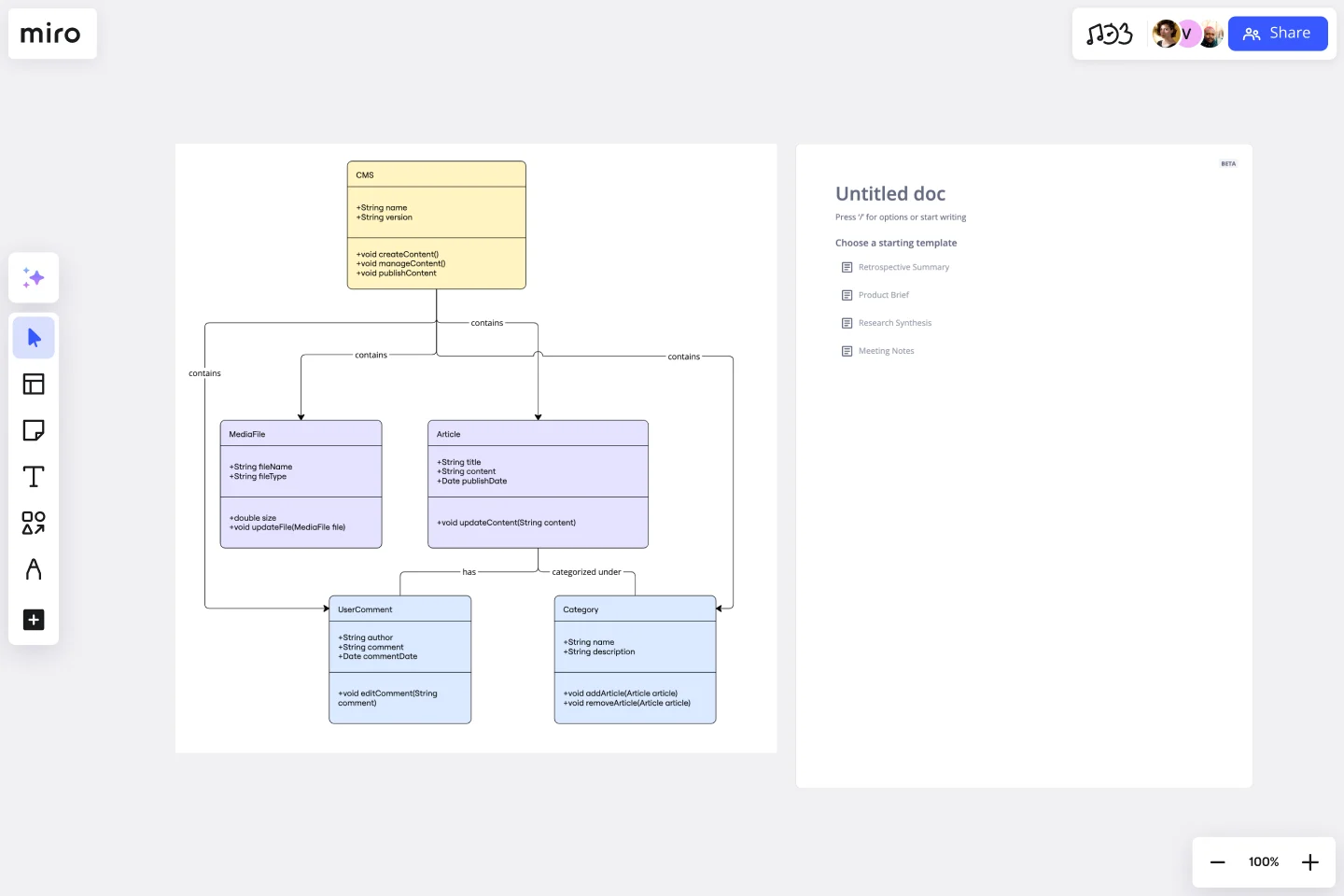UML Class Content Management System (CMS) Template
Improve the quality of the CMS architecture design with the UML Class Content Management System Template.
Available on Enterprise, Business, Education plans.
About the UML Class Content Management System (CMS) Template
The UML Class Content Management System (CMS) Template is a designed blueprint that helps visualize the structure of a CMS. This template showcases the key classes and their relationships within a CMS, illustrating how users create, manage, and publish digital content such as articles, comments, and files. It serves as a map, detailing the classes or objects in the system, their attributes, methods, and the relationships among them, including inheritance, association, aggregation, or composition. This visual representation is invaluable for understanding and documenting the architecture of a CMS.
How to use the UML Class Content Management System (CMS) Template
Customization: Once the template is added to your board, you can collaborate with your team in real-time or asynchronously to customize the diagram. This involves tailoring the classes, attributes, methods, and relationships to fit the specific requirements of your CMS.
Collaboration: Use Miro's collaborative features to brainstorm designs, leave feedback, and discuss the UML diagram with your team. The real time update capability of Miro boards ensures that everyone is always looking at the latest version of the diagram.
Use tools: For building UML diagrams from scratch or further customization, you can use Miro AI or UML shape packs available within Miro. These tools can help in automatically generating UML diagrams or adding specific elements to your template.
Review and iterate: Review the UML diagram with your team, making use of Miro's commenting and feedback tools. Iterate on the design as necessary to ensure it accurately represents the CMS architecture you are documenting.
Why use the UML Class Content Management System (CMS) Template
Using the UML Class Content Management System (CMS) Template in Miro has several advantages:
Clarity: It provides a clear and structured visualization of the CMS architecture, making it easier to understand the system's components and their interactions.
Efficiency: The template accelerates the documentation process, allowing you to quickly map out the CMS structure without starting from scratch.
Collaboration: Miro's platform is designed for seamless collaboration, making it easy for teams to work together on the UML Class Content Management System (CMS) Template. Team members can contribute, edit, and comment in real time, ensuring that everyone's insights are incorporated. This collaborative environment fosters a more inclusive and comprehensive design process.
Flexibility: The template is highly customizable, allowing teams to adapt it to their specific project needs. Whether you're working on a small-scale CMS or a complex, enterprise-level system, the template can be tailored to suit your requirements. This flexibility ensures that the UML diagram remains relevant and useful throughout the development process.
Visualization: A well-structured UML diagram, like the one provided by this template, offers a visual representation of the system's architecture. This makes it easier to identify potential issues, understand the flow of data, and communicate complex ideas to stakeholders who may not be familiar with UML notation.
Documentation: Using the UML Class Content Management System (CMS) Template helps create comprehensive documentation of your CMS's architecture. This documentation is invaluable for onboarding new team members, facilitating maintenance, and providing a reference for future development efforts.
Get started with this template right now. Available on Enterprise, Business, Education plans.
20/80 Process Diagram - EOS Compatible
Works best for:
Diagramming
The 20/80 Process Diagram - EOS® Compatible template is a visual tool for mapping out processes and workflows aligned with the Entrepreneurial Operating System (EOS®) methodology. It provides a structured framework for identifying core processes and key activities that drive business outcomes. This template enables organizations to streamline operations, clarify roles and responsibilities, and enhance accountability. By promoting alignment with EOS® principles, the 20/80 Process Diagram empowers teams to achieve organizational excellence and drive sustainable growth.
UML Class Diagram by Dmitry Ermakov
Works best for:
Customer Journey Map
A UML (Unified Modeling Language) Class diagram is a visual representation that shows the structure and relationships of classes in a system or software application.
Fishbone Diagram Template
Works best for:
Operations, Diagrams, Workflows
What is the best way to solve any problem your team faces? Go straight to the root. That means identifying the root causes of the problem, and fishbone diagrams are designed to help you do it best. Also known as the Ishikawa Diagram (named after Japanese quality control expert Kaoru Ishikawa), fishbone diagrams allow teams to visualize all possible causes of a problem, to explore and understand how they fit together holistically. Teams can also use fishbone diagrams as a starting point for thinking about what the root cause of a future problem might be.
UML Component Diagram Template
Works best for:
Mapping, Diagrams, Software Development
Use our Component Diagram template to show how a system’s physical components are organized and wired together. Visualize implementation details, make sure planned development matches system needs, and more — all in a collaborative environment.
Social Media Strategy Planning
Works best for:
Roadmap, Planning, Mapping
The Social Media Strategy Planning template provides a structured approach for developing and implementing social media strategies. By defining objectives, target audiences, and content plans, teams can maximize the impact of their social media efforts. This template fosters collaboration and alignment across teams, ensuring that social media initiatives are integrated with broader marketing goals and contribute to overall business objectives.
Calendar 2024 - a Year timeline
Works best for:
Strategy, Planning
The Calendar 2024 a year Timeline template is perfect for planning and organizing your year. It helps you schedule important dates, track annual goals, and stay on top of deadlines. This template ensures you have a clear overview of your year ahead.
